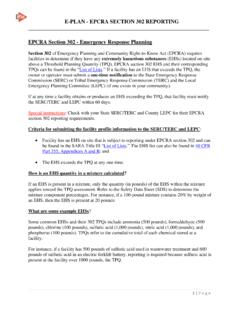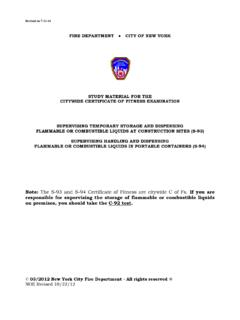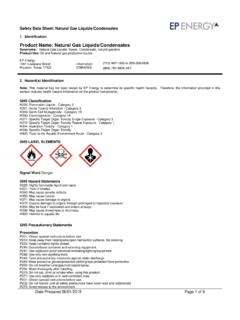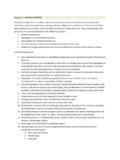Transcription of GUIDE fLaMMabLe LiqUids 128 (Water-iMMisCibLe
1 ERG 2016 Page 194 GUIDE128 FIRE Dry Water Move Fight Cool Withdraw ALWAYS ForSPILL OR LEAK ELIMINATE All Do Stop Prevent A Absorb Use Dike WaterFIRST AID Ensure Move Call Give Administer Remove In Wash In Keep POTENTIAL HAZARDSFIRE OR EXPLOSION HIGHLY fLaMMabLe : Will be easily ignited by heat, sparks or flames. Vapors may form explosive mixtures with air. Vapors may travel to source of ignition and flash back. Most vapors are heavier than air. They will spread along ground and collect in low or confined areas (sewers, basements, tanks).
2 Vapor explosion hazard indoors, outdoors or in sewers. Those substances designated with a (P) may polymerize explosively when heated or involved in a fire. Runoff to sewer may create fire or explosion hazard. Containers may explode when heated. Many LiqUids are lighter than water. Substance may be transported hot. For hybrid vehicles, GUIDE 147 (lithium ion batteries) or GUIDE 138 (sodium batteries) should also be consulted. If molten aluminum is involved, refer to GUIDE Inhalation or contact with material may irritate or burn skin and eyes. Fire may produce irritating, corrosive and/or toxic gases.
3 Vapors may cause dizziness or suffocation. Runoff from fire control or dilution water may cause SAFETY CALL EMERGENCY RESPONSE Telephone Number on Shipping Paper first. If Shipping Paper not available or no answer, refer to appropriate telephone number listed on the inside back cover. As an immediate precautionary measure, isolate spill or leak area for at least 50 meters (150 feet) in all directions. Keep unauthorized personnel away. Stay upwind, uphill and/or upstream. Ventilate closed spaces before CLOTHING Wear positive pressure self-contained breathing apparatus (SCBA).
4 Structural firefighters protective clothing will only provide limited Spill Consider initial downwind evacuation for at least 300 meters (1000 feet).Fire If tank, rail car or tank truck is involved in a fire, ISOLATE for 800 meters (1/2 mile) in all directions; also, consider initial evacuation for 800 meters (1/2 mile) in all LiqUids (Water-iMMisCibLe )In Canada, an Emergency Response Assistance Plan (ERAP) may be required for this product. Please consult the shipping document and/or the ERAP Program Section (page 391).Page 195 ERG 2016 GUIDE128 EMERGENCY RESPONSEFIRECAUTION: All these products have a very low flash point: Use of water spray when fighting fire may be : For mixtures containing alcohol or polar solvent, alcohol-resistant foam may be more Fire Dry chemical, CO2, water spray or regular Fire Water spray, fog or regular foam.
5 Do not use straight streams. Move containers from fire area if you can do it without involving Tanks or Car/Trailer Loads Fight fire from maximum distance or use unmanned hose holders or monitor nozzles. Cool containers with flooding quantities of water until well after fire is out. Withdraw immediately in case of rising sound from venting safety devices or discoloration of tank. ALWAYS stay away from tanks engulfed in fire. For massive fire, use unmanned hose holders or monitor nozzles; if this is impossible, withdraw from area and let fire OR LEAK ELIMINATE all ignition sources (no smoking, flares, sparks or flames in immediate area).
6 All equipment used when handling the product must be grounded. Do not touch or walk through spilled material. Stop leak if you can do it without risk. Prevent entry into waterways, sewers, basements or confined areas. A vapor-suppressing foam may be used to reduce vapors. Absorb or cover with dry earth, sand or other non-combustible material and transfer to containers. Use clean, non-sparking tools to collect absorbed Spill Dike far ahead of liquid spill for later disposal. Water spray may reduce vapor, but may not prevent ignition in closed AID Ensure that medical personnel are aware of the material(s) involved and take precautions to protect themselves.
7 Move victim to fresh air. Call 911 or emergency medical service. Give artificial respiration if victim is not breathing. Administer oxygen if breathing is difficult. Remove and isolate contaminated clothing and shoes. In case of contact with substance, immediately flush skin or eyes with running water for at least 20 minutes. Wash skin with soap and water. In case of burns, immediately cool affected skin for as long as possible with cold water. Do not remove clothing if adhering to skin. Keep victim calm and EMERGENCY RESPONSE Telephone Number on Shipping Paper first.
8 If Shipping Paper not fLaMMabLe LiqUids (Water-iMMisCibLe )






